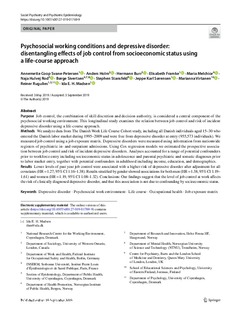| dc.contributor.author | Svane-Petersen, Annemette Coop | |
| dc.contributor.author | Holm, Anders | |
| dc.contributor.author | Burr, Hermann | |
| dc.contributor.author | Framke, Elisabeth | |
| dc.contributor.author | Melchior, Maria | |
| dc.contributor.author | Rod, Naja Hulvej | |
| dc.contributor.author | Sivertsen, Børge | |
| dc.contributor.author | Stansfeld, Stephen A. | |
| dc.contributor.author | Sørensen, Jeppe Karl | |
| dc.contributor.author | Virtanen, Marianna | |
| dc.contributor.author | Rugulies, Reiner | |
| dc.contributor.author | Madsen, Ida E.H. | |
| dc.date.accessioned | 2020-01-13T09:51:43Z | |
| dc.date.available | 2020-01-13T09:51:43Z | |
| dc.date.created | 2019-12-08T12:06:50Z | |
| dc.date.issued | 2019 | |
| dc.identifier.citation | Social Psychiatry and Psychiatric Epidemiology. 2019, . | nb_NO |
| dc.identifier.issn | 0933-7954 | |
| dc.identifier.uri | http://hdl.handle.net/11250/2635883 | |
| dc.description.abstract | Purpose
Job control, the combination of skill discretion and decision authority, is considered a central component of the psychosocial working environment. This longitudinal study examines the relation between job control and risk of incident depressive disorder using a life-course approach.
Methods
We analyze data from The Danish Work Life Course Cohort study, including all Danish individuals aged 15–30 who entered the Danish labor market during 1995–2009 and were free from depressive disorder at entry (955,573 individuals). We measured job control using a job exposure matrix. Depressive disorders were measured using information from nationwide registers of psychiatric in- and outpatient admissions. Using Cox regression models we estimated the prospective association between job control and risk of incident depressive disorders. Analyses accounted for a range of potential confounders prior to workforce entry including socioeconomic status in adolescence and parental psychiatric and somatic diagnoses prior to labor market entry, together with potential confounders in adulthood including income, education, and demographics.
Results
Lower levels of past year job control were associated with a higher risk of depressive disorder after adjustment for all covariates (HR = 1.27, 95% CI 1.16–1.38). Results stratified by gender showed associations for both men (HR = 1.38, 95% CI 1.19–1.61) and women (HR = 1.19, 95% CI 1.08–1.32). Conclusions: Our findings suggest that the level of job control at work affects the risk of clinically diagnosed depressive disorder, and that this association is not due to confounding by socioeconomic status. | nb_NO |
| dc.language.iso | eng | nb_NO |
| dc.publisher | Springer Verlag | nb_NO |
| dc.rights | Navngivelse 4.0 Internasjonal | * |
| dc.rights.uri | http://creativecommons.org/licenses/by/4.0/deed.no | * |
| dc.title | Psychosocial working conditions and depressive disorder: disentangling effects of job control from socioeconomic status using a life-course approach | nb_NO |
| dc.type | Journal article | nb_NO |
| dc.type | Peer reviewed | nb_NO |
| dc.description.version | publishedVersion | nb_NO |
| dc.source.pagenumber | 12 | nb_NO |
| dc.source.journal | Social Psychiatry and Psychiatric Epidemiology | nb_NO |
| dc.identifier.doi | 10.1007/s00127-019-01769-9 | |
| dc.identifier.cristin | 1757901 | |
| dc.description.localcode | © The Author(s) 2019 Open Access This article is distributed under the terms of the Creative Commons Attribution 4.0 International License (http://creativecommons.org/licenses/by/4.0/) | nb_NO |
| cristin.unitcode | 194,65,35,0 | |
| cristin.unitname | Institutt for psykisk helse | |
| cristin.ispublished | true | |
| cristin.fulltext | original | |
| cristin.qualitycode | 1 | |

